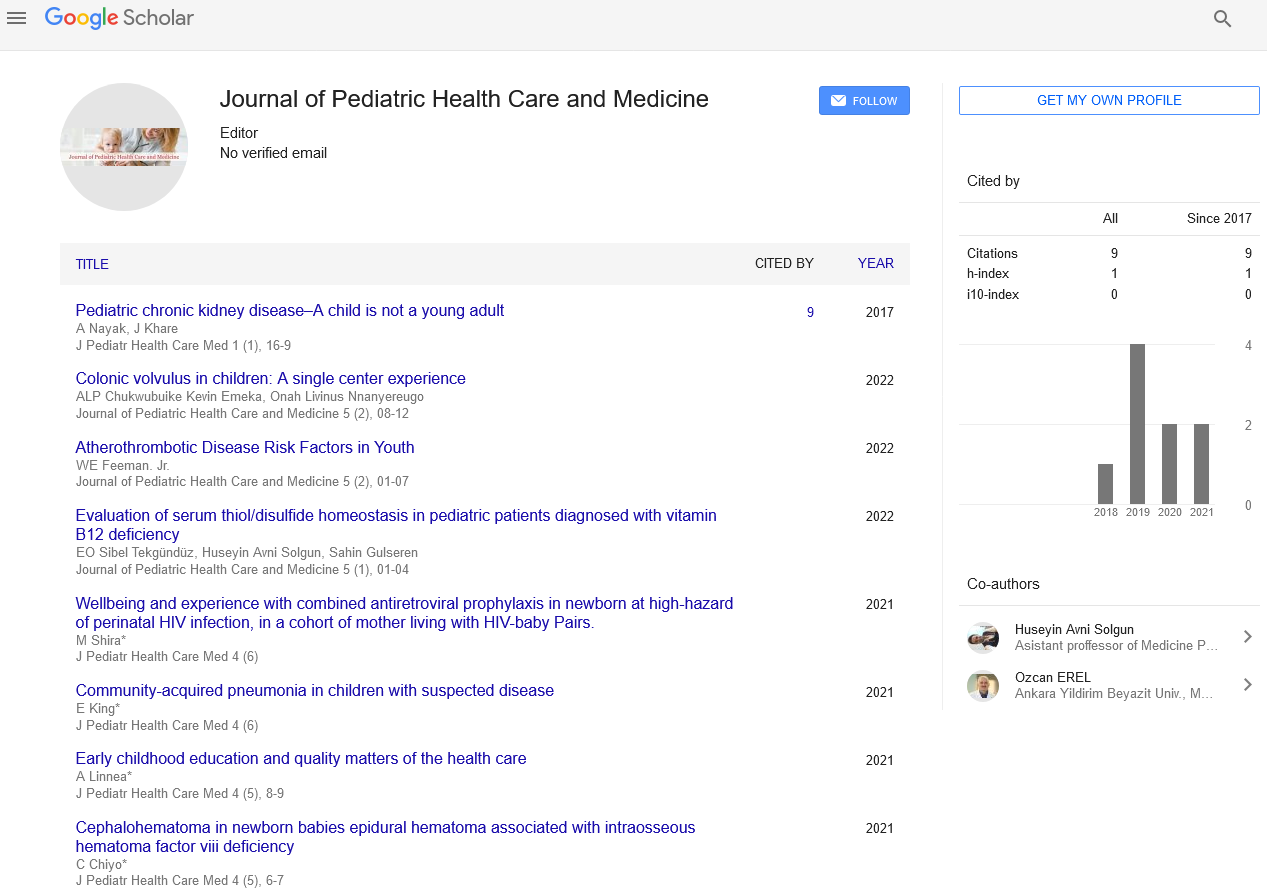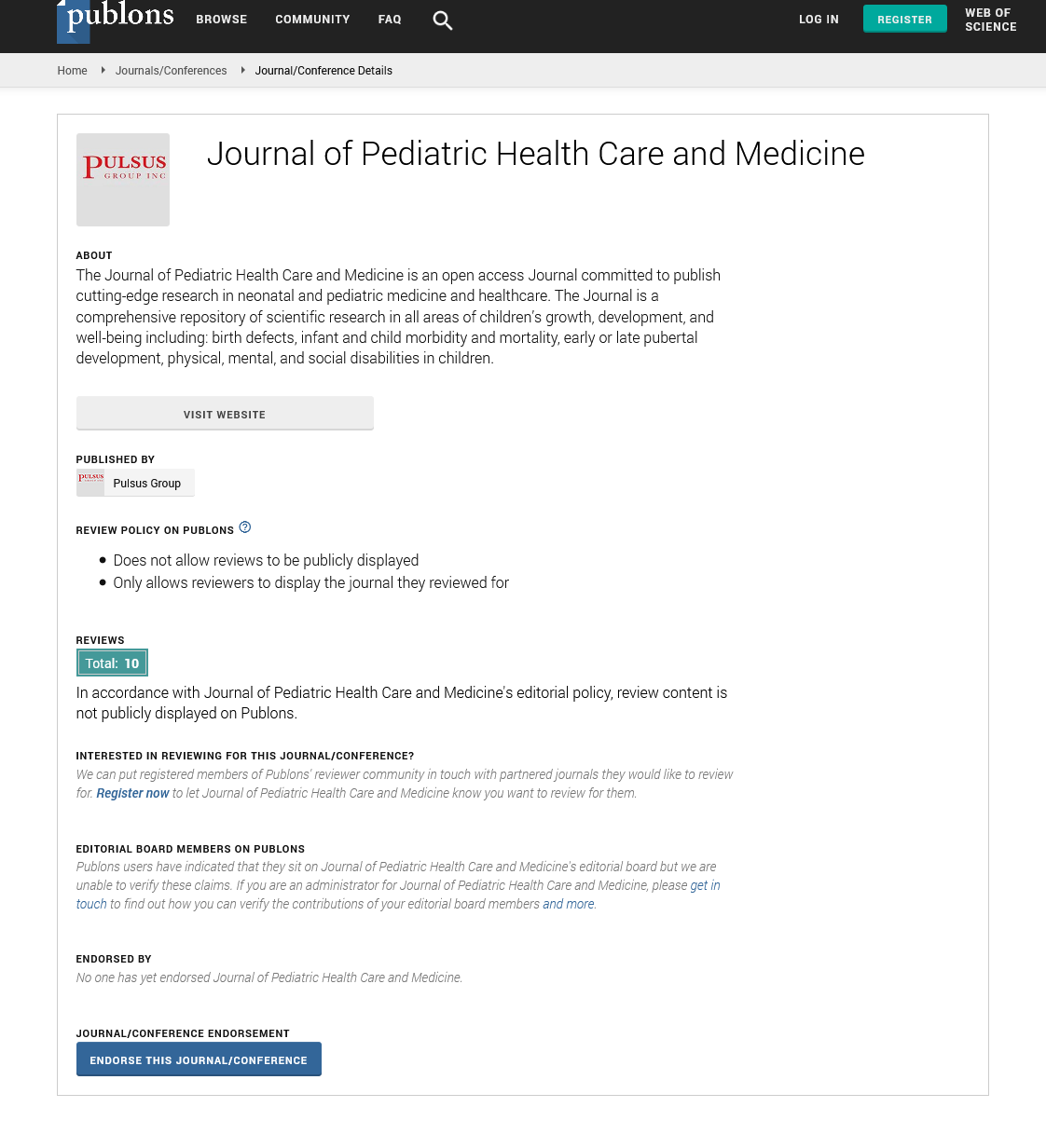Community-acquired pneumonia in children with suspected disease
Received: 25-Nov-2021 Accepted Date: Dec 08, 2021; Published: 15-Dec-2021
Citation: Ele King. Community-acquired pneumonia in children with suspected disease. J Pediatr Health Care Med. 2021; 4(6): 14.
This open-access article is distributed under the terms of the Creative Commons Attribution Non-Commercial License (CC BY-NC) (http://creativecommons.org/licenses/by-nc/4.0/), which permits reuse, distribution and reproduction of the article, provided that the original work is properly cited and the reuse is restricted to noncommercial purposes. For commercial reuse, contact reprints@pulsus.com
Abstract
Plasma proadrenomedullin (proADM) is a promising biomarker to foresee sickness seriousness in local area gained pneumonia (CAP). Urinary biomarkers offer benefits over blood, including simplicity of assortment. We assessed the relationship between urinary proADM and illness seriousness in pediatric CAP. Outcomes were examined using logistic regression within the cohort with suspected CAP and in a subset with radiographic CAP.
Keywords
Clinical Record; Radiographic CAP; Hospitalization
Introduction
The Local area obtained pneumonia (CAP) is the most widely recognized genuine bacterial contamination in youngsters and a main source of pediatric hospitalization. Accurate danger appraisal is needed to limit pointless tests, medicines and hospitalizations while zeroing in basic treatments on those at the most noteworthy danger of serious results. Nonetheless, not many objective prognostic devices exist for youngsters with CAP. Without such apparatuses, clinical administration for kids with CAP can be wasteful and likely to variability. Biomarkers can illuminate the board choices by giving a true means to survey illness seriousness. Acquiring blood for biomarker estimations in youngsters has a few inconveniences, including torment, tension and need for specialized and procedural skill. Besides, numerous youngsters with suspected CAP won’t have venipuncture proceeded as a feature of routine clinical consideration. Noninvasive biomarkers, like those deliberate in pee, offer a few significant benefits, including simplicity of assortment, cost-adequacy, and absence of inconvenience. In little investigations, urinary adrenomedullin has been related with urinary plot contamination and irritation [1].
According to some eminent workers, a common pattern of variations may be found associated with gall bladder. These variations are due to arrest or deviation in normal embryological development. This knowledge of different variations and anomalies is necessary for surgeons during laparoscopic surgeries to prevent iatrogenic injuries those can leads to increase morbidity and mortality [2].
The present study describes variations seen in external morphology of gall bladder along with incidence and differences in dimensions and shapes
Study Procedures
The patient as well as parent gave segment and recorded data. ED clinicians really focusing on the patients detailed clinical signs. Blood, pee, or potentially nasopharyngeal swabs were gathered at enlistment. Tests for blood proADM examination were brought into either a Li-heparin or EDTA tube and set into a 4C cooler following assortment [3]. Plasma was isolated from serum and frozen at 80C inside 48 hours of assortment. Pee was gathered into a sterile compartment straightforwardly from more established youngsters or from pee splashed cotton balls put through a needle for more youthful kids. The clean holders were immunized with sodium azide to repress bacterial overgrowth.19 Clinical information were separated from the electronic clinical record. Patients got a subsequent call 710 days after release [4].
Conclusion
The Urinary proADM/Cr proportion estimated at the hour of crisis division visit was measurably connected with the improvement of serious results in youngsters with CAP, with more grounded biased execution in radiographic infection. In this planned partner investigation of kids introducing to the ED with suspected CAP, we found that the urinary proADM/Cr proportion estimated at the hour of ED visit is genuinely connected with the improvement of extreme results. Execution was more grounded in the subset of kids with radiographic CAP, while generally speaking execution was restricted in the bigger associate of suspected CAP. At the point when outrageous exceptions were eliminated, a multiplying of the proADM/Cr proportion was related with a 12% increment in the chances of extreme illness in those with radiographic CAP.
REFERENCES
- Keren R, Luan X, Localio R, et al. Pediatric Research in Inpatient Settings (PRIS) Network. Prioritization of comparative effectiveness research topics in hospital pediatrics. Arch Pediatr Adolesc Med. 2012;166:1155–1164.
- Florin TA, French B, Zorc JJ, et al. Variation in emergency department diagnostic testing and disposition outcomes in pneumonia. Pediatrics. 2013;132:237–244.
- Beck AF, Florin TA, Campanella S, et al. Geographic variation in hospitalization for lower respiratory tract infections across one county. JAMA Pediatr. 2015;169:846–854.
- Kubo A, Minamino N, Isumi Y, et al. Production of adrenomedullin in macrophage cell line and peritoneal macrophage. J Biol Chem. 1998;273:16730–16738.






